美国高等教育
- 格式:ppt
- 大小:586.50 KB
- 文档页数:29

美国高等教育毛入学率美国高等教育发展史美国的高等教育始于殖民地时期,以1492 年哥伦布发现了新大陆为起点,欧洲人开始向殖民地建立一些教会学校。
后来,英国的清教徒们为了逃避英国国王的迫害①,来到了美洲,传播他们的教义,于是美国的大学出现了。
事实上,在欧洲人进入美洲之前。
印第安人有自己的一套很完善的对青少年和儿童的教育与训练制度。
印第安人在成为成熟的部落成员前,需要掌握三项技能,他们包括:实用技能与生存技能;传统文化知识;精神意识。
生存训练是建立在自然认识之上的,它包括对地理、温度、水源及其他状况的了解程度。
在人类的历史上,各个民族都在历史的发展中留下了丰富的文化遗产。
印第安的文化遗产也表现出多样的文化类型、标准、社会结构和行为方式。
在精神意识方面,印第安人要求所有的青少年都要具有精神意识,他们的精神意识往往意味着灵与物,自然与超自然。
美国在殖民地时期有过一部教育法——马萨诸塞教育法②,颁布于1642 年。
这部法律不仅旨在扫盲,更确切地是为了强化社会秩序。
5 年后,殖民地又颁布了1947 年教育法,即有名的“老骗子撒旦法”。
该法要求建立学校,它规定凡满50户人家的城镇“必须立即任命一名教师来教本镇所有儿童读书写字”;凡满100户人家的城镇“必须设立一所文法学校,以便于教师教导青年使他们有机会进入大学深造。
”无论是1642 年的教育法还是1647 年的教育法中都未提及教会或牧师。
而且,教育被视为地方官员的主要责任。
这就奠定了美国教育制度基础——地方负责制。
虽然殖民者所处的地理位置和环境各不相同,但是,他们对于高等教育都抱有同样的热情。
因为在来到美国的殖民者中,每30 人中就有1 个人毕业于英格兰的剑桥大学,剩下的人要么毕业于牛津大学,要么毕业于英国的其他大学。
北美殖民地上的第一所学院是哈佛学院。
1636 年,马萨诸塞议会(General Court ofMassachusetts)应约翰· 哈佛牧师的医院,将他的图书馆和一半的财产用于建立一所“学校或学院”。
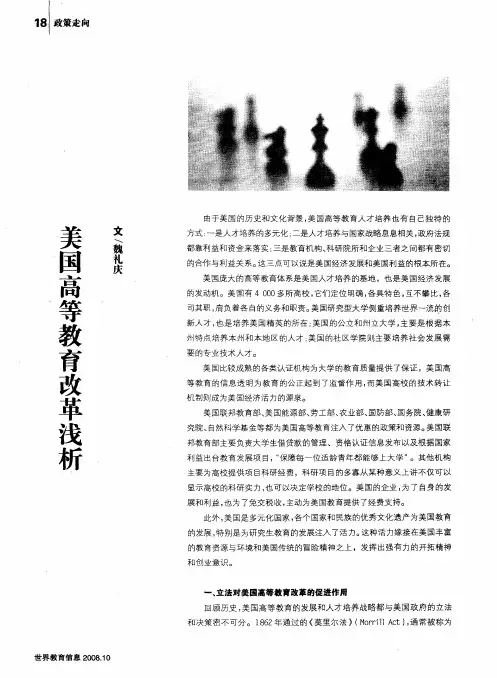
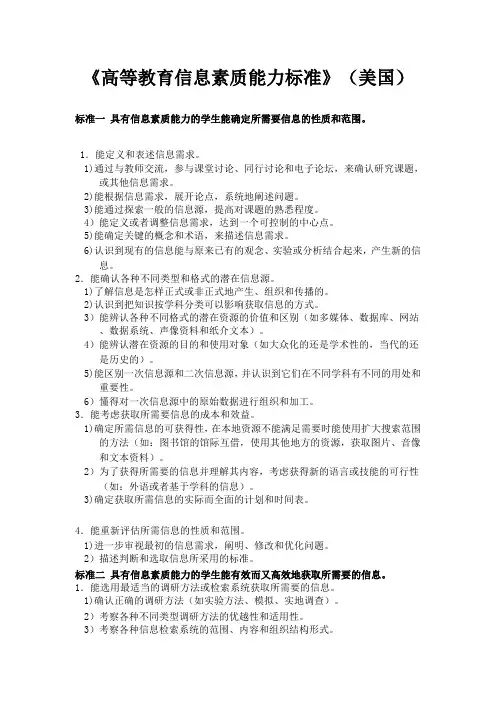
《高等教育信息素质能力标准》(美国)标准一具有信息素质能力的学生能确定所需要信息的性质和范围。
1.能定义和表述信息需求。
1)通过与教师交流,参与课堂讨论、同行讨论和电子论坛,来确认研究课题,或其他信息需求。
2)能根据信息需求,展开论点,系统地阐述问题。
3)能通过探索一般的信息源,提高对课题的熟悉程度。
4)能定义或者调整信息需求,达到一个可控制的中心点。
5)能确定关键的概念和术语,来描述信息需求。
6)认识到现有的信息能与原来已有的观念、实验或分析结合起来,产生新的信息。
2.能确认各种不同类型和格式的潜在信息源。
1)了解信息是怎样正式或非正式地产生、组织和传播的。
2)认识到把知识按学科分类可以影响获取信息的方式。
3)能辨认各种不同格式的潜在资源的价值和区别(如多媒体、数据库、网站、数据系统、声像资料和纸介文本)。
4)能辨认潜在资源的目的和使用对象(如大众化的还是学术性的,当代的还是历史的)。
5)能区别一次信息源和二次信息源,并认识到它们在不同学科有不同的用处和重要性。
6)懂得对一次信息源中的原始数据进行组织和加工。
3.能考虑获取所需要信息的成本和效益。
1)确定所需信息的可获得性,在本地资源不能满足需要时能使用扩大搜索范围的方法(如:图书馆的馆际互借,使用其他地方的资源,获取图片、音像和文本资料)。
2)为了获得所需要的信息并理解其内容,考虑获得新的语言或技能的可行性(如:外语或者基于学科的信息)。
3)确定获取所需信息的实际而全面的计划和时间表。
4.能重新评估所需信息的性质和范围。
1)进一步审视最初的信息需求,阐明、修改和优化问题。
2)描述判断和选取信息所采用的标准。
标准二具有信息素质能力的学生能有效而又高效地获取所需要的信息。
1.能选用最适当的调研方法或检索系统获取所需要的信息。
1)确认正确的调研方法(如实验方法、模拟、实地调查)。
2)考察各种不同类型调研方法的优越性和适用性。
3)考察各种信息检索系统的范围、内容和组织结构形式。
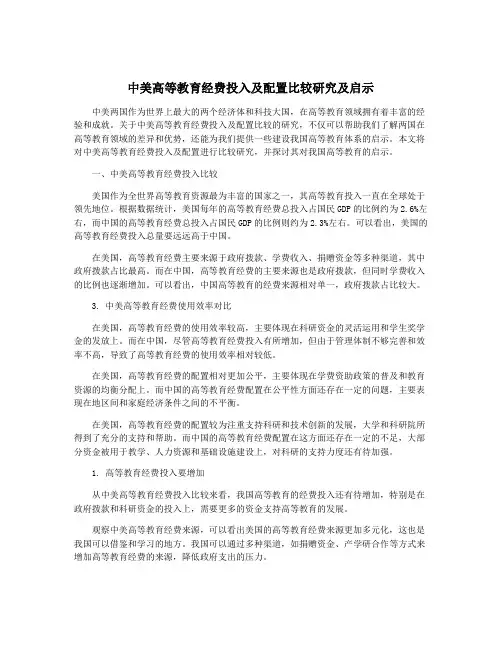
中美高等教育经费投入及配置比较研究及启示中美两国作为世界上最大的两个经济体和科技大国,在高等教育领域拥有着丰富的经验和成就。
关于中美高等教育经费投入及配置比较的研究,不仅可以帮助我们了解两国在高等教育领域的差异和优势,还能为我们提供一些建设我国高等教育体系的启示。
本文将对中美高等教育经费投入及配置进行比较研究,并探讨其对我国高等教育的启示。
一、中美高等教育经费投入比较美国作为全世界高等教育资源最为丰富的国家之一,其高等教育投入一直在全球处于领先地位。
根据数据统计,美国每年的高等教育经费总投入占国民GDP的比例约为2.6%左右,而中国的高等教育经费总投入占国民GDP的比例则约为2.3%左右。
可以看出,美国的高等教育经费投入总量要远远高于中国。
在美国,高等教育经费主要来源于政府拨款、学费收入、捐赠资金等多种渠道,其中政府拨款占比最高。
而在中国,高等教育经费的主要来源也是政府拨款,但同时学费收入的比例也逐渐增加。
可以看出,中国高等教育的经费来源相对单一,政府拨款占比较大。
3. 中美高等教育经费使用效率对比在美国,高等教育经费的使用效率较高,主要体现在科研资金的灵活运用和学生奖学金的发放上。
而在中国,尽管高等教育经费投入有所增加,但由于管理体制不够完善和效率不高,导致了高等教育经费的使用效率相对较低。
在美国,高等教育经费的配置相对更加公平,主要体现在学费资助政策的普及和教育资源的均衡分配上。
而中国的高等教育经费配置在公平性方面还存在一定的问题,主要表现在地区间和家庭经济条件之间的不平衡。
在美国,高等教育经费的配置较为注重支持科研和技术创新的发展,大学和科研院所得到了充分的支持和帮助。
而中国的高等教育经费配置在这方面还存在一定的不足,大部分资金被用于教学、人力资源和基础设施建设上,对科研的支持力度还有待加强。
1. 高等教育经费投入要增加从中美高等教育经费投入比较来看,我国高等教育的经费投入还有待增加,特别是在政府拨款和科研资金的投入上,需要更多的资金支持高等教育的发展。
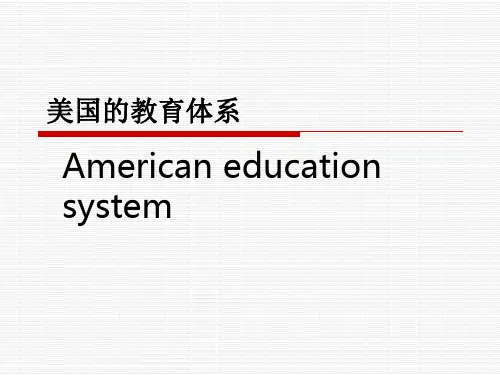
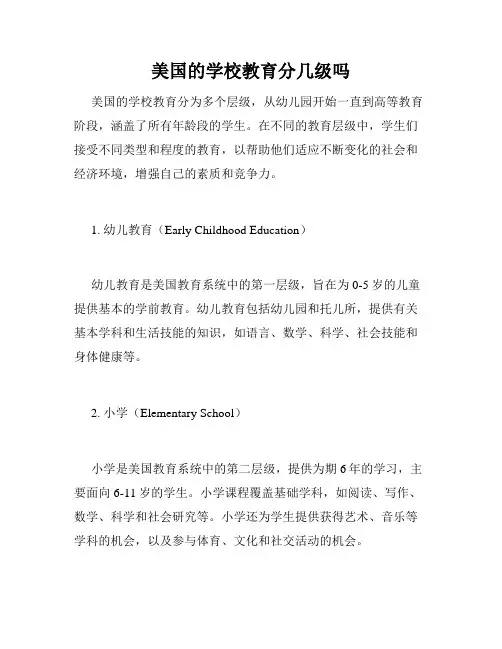
美国的学校教育分几级吗美国的学校教育分为多个层级,从幼儿园开始一直到高等教育阶段,涵盖了所有年龄段的学生。
在不同的教育层级中,学生们接受不同类型和程度的教育,以帮助他们适应不断变化的社会和经济环境,增强自己的素质和竞争力。
1. 幼儿教育(Early Childhood Education)幼儿教育是美国教育系统中的第一层级,旨在为0-5岁的儿童提供基本的学前教育。
幼儿教育包括幼儿园和托儿所,提供有关基本学科和生活技能的知识,如语言、数学、科学、社会技能和身体健康等。
2. 小学(Elementary School)小学是美国教育系统中的第二层级,提供为期6年的学习,主要面向6-11岁的学生。
小学课程覆盖基础学科,如阅读、写作、数学、科学和社会研究等。
小学还为学生提供获得艺术、音乐等学科的机会,以及参与体育、文化和社交活动的机会。
3. 初中(Middle School)初中是美国教育系统中的第三层级,为期3年,主要面向12-14岁的学生。
初中课程覆盖小学学科内容的深度和广度,同时还涉及到艺术和文化等领域的学习。
初中还提供机会让学生参与体育和社交活动,以发展他们的个人素质。
4. 高中(High School)高中是美国教育系统中的第四层级,为期4年,主要面向15-18岁的学生。
高中课程可以分为两类:普通教育和职业教育。
普通教育课程包括英语、数学、科学、社会科学和外语等学科。
职业教育课程则帮助学生培养实际技能,使他们能够适应不同的工作环境和需求。
高中学生参与体育、艺术和文化活动的机会也很多。
5. 大学本科(Undergraduate Education)大学本科是美国教育系统中的第五层级,提供为期4年的学习,主要面向高中毕业生。
大学本科课程主要分为文理科和职业教育两类。
文理科主要课程包括英语、数学、科学和社会科学等基础学科,同时包括艺术、人文学科等。
职业教育课程则覆盖实际技能和经验,为学生提供准备他们成为各种职业人士的机会。
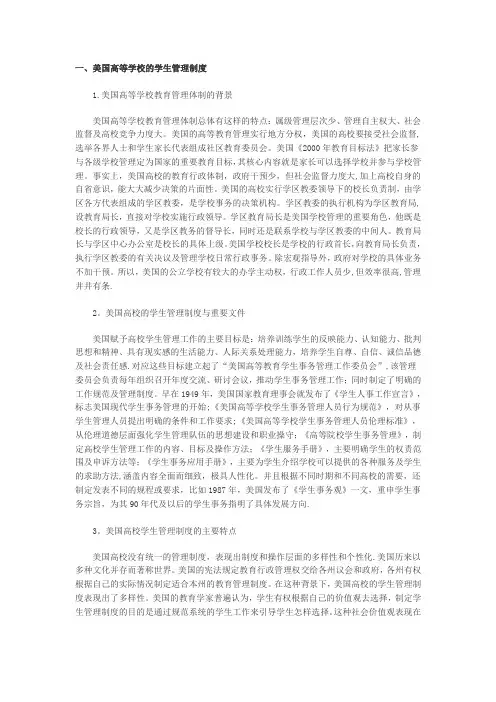
一、美国高等学校的学生管理制度1.美国高等学校教育管理体制的背景美国高等学校教育管理体制总体有这样的特点:属级管理层次少、管理自主权大、社会监督及高校竞争力度大。
美国的高等教育管理实行地方分权,美国的高校要接受社会监督,选举各界人士和学生家长代表组成社区教育委员会。
美国《2000年教育目标法》把家长参与各级学校管理定为国家的重要教育目标,其核心内容就是家长可以选择学校并参与学校管理。
事实上,美国高校的教育行政体制,政府干预少,但社会监督力度大,加上高校自身的自省意识,能大大减少决策的片面性。
美国的高校实行学区教委领导下的校长负责制,由学区各方代表组成的学区教委,是学校事务的决策机构。
学区教委的执行机构为学区教育局,设教育局长,直接对学校实施行政领导。
学区教育局长是美国学校管理的重要角色,他既是校长的行政领导,又是学区教务的督导长,同时还是联系学校与学区教委的中间人。
教育局长与学区中心办公室是校长的具体上级。
美国学校校长是学校的行政首长,向教育局长负责,执行学区教委的有关决议及管理学校日常行政事务。
除宏观指导外,政府对学校的具体业务不加干预。
所以,美国的公立学校有较大的办学主动权,行政工作人员少,但效率很高,管理井井有条.2。
美国高校的学生管理制度与重要文件美国赋予高校学生管理工作的主要目标是:培养训练学生的反映能力、认知能力、批判思想和精神、具有现实感的生活能力、人际关系处理能力,培养学生自尊、自信、诚信品德及社会责任感.对应这些目标建立起了“美国高等教育学生事务管理工作委员会”,该管理委员会负责每年组织召开年度交流、研讨会议,推动学生事务管理工作;同时制定了明确的工作规范及管理制度。
早在1949年,美国国家教育理事会就发布了《学生人事工作宣言》,标志美国现代学生事务管理的开始;《美国高等学校学生事务管理人员行为规范》,对从事学生管理人员提出明确的条件和工作要求;《美国高等学校学生事务管理人员伦理标准》,从伦理道德层面强化学生管理队伍的思想建设和职业操守;《高等院校学生事务管理》,制定高校学生管理工作的内容、目标及操作方法;《学生服务手册》,主要明确学生的权责范围及申诉方法等;《学生事务应用手册》,主要为学生介绍学校可以提供的各种服务及学生的求助方法,涵盖内容全面而细致,极具人性化。

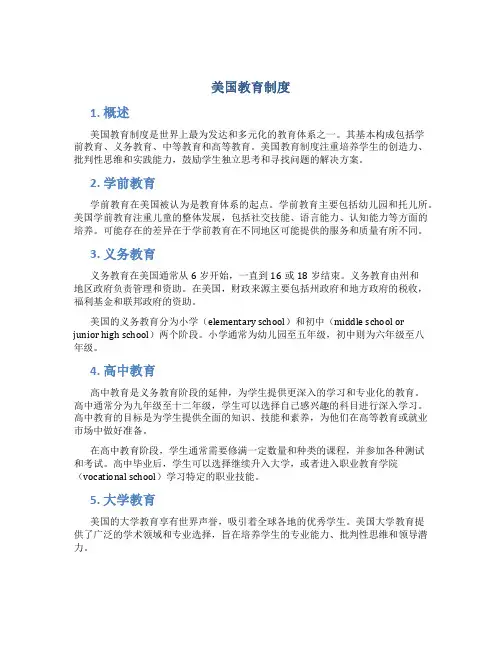
美国教育制度1. 概述美国教育制度是世界上最为发达和多元化的教育体系之一。
其基本构成包括学前教育、义务教育、中等教育和高等教育。
美国教育制度注重培养学生的创造力、批判性思维和实践能力,鼓励学生独立思考和寻找问题的解决方案。
2. 学前教育学前教育在美国被认为是教育体系的起点。
学前教育主要包括幼儿园和托儿所。
美国学前教育注重儿童的整体发展,包括社交技能、语言能力、认知能力等方面的培养。
可能存在的差异在于学前教育在不同地区可能提供的服务和质量有所不同。
3. 义务教育义务教育在美国通常从6岁开始,一直到16或18岁结束。
义务教育由州和地区政府负责管理和资助。
在美国,财政来源主要包括州政府和地方政府的税收,福利基金和联邦政府的资助。
美国的义务教育分为小学(elementary school)和初中(middle school or junior high school)两个阶段。
小学通常为幼儿园至五年级,初中则为六年级至八年级。
4. 高中教育高中教育是义务教育阶段的延伸,为学生提供更深入的学习和专业化的教育。
高中通常分为九年级至十二年级,学生可以选择自己感兴趣的科目进行深入学习。
高中教育的目标是为学生提供全面的知识、技能和素养,为他们在高等教育或就业市场中做好准备。
在高中教育阶段,学生通常需要修满一定数量和种类的课程,并参加各种测试和考试。
高中毕业后,学生可以选择继续升入大学,或者进入职业教育学院(vocational school)学习特定的职业技能。
5. 大学教育美国的大学教育享有世界声誉,吸引着全球各地的优秀学生。
美国大学教育提供了广泛的学术领域和专业选择,旨在培养学生的专业能力、批判性思维和领导潜力。
美国的大学教育分为本科教育和研究生教育两个层次。
本科教育通常需要花费四年时间,学生可以选择修习自己感兴趣的主修学科,并在其他学科中选择一定数量的选修课程。
研究生教育则是进一步深造的机会,提供更高级别的学术研究和专业发展。
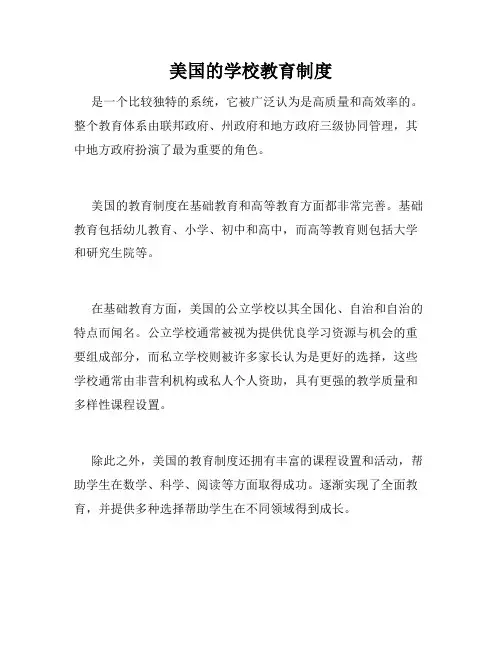
美国的学校教育制度是一个比较独特的系统,它被广泛认为是高质量和高效率的。
整个教育体系由联邦政府、州政府和地方政府三级协同管理,其中地方政府扮演了最为重要的角色。
美国的教育制度在基础教育和高等教育方面都非常完善。
基础教育包括幼儿教育、小学、初中和高中,而高等教育则包括大学和研究生院等。
在基础教育方面,美国的公立学校以其全国化、自治和自治的特点而闻名。
公立学校通常被视为提供优良学习资源与机会的重要组成部分,而私立学校则被许多家长认为是更好的选择,这些学校通常由非营利机构或私人个人资助,具有更强的教学质量和多样性课程设置。
除此之外,美国的教育制度还拥有丰富的课程设置和活动,帮助学生在数学、科学、阅读等方面取得成功。
逐渐实现了全面教育,并提供多种选择帮助学生在不同领域得到成长。
此外,美国教育中也有一个重要的组成部分,即教师的角色。
教师不仅是学生学术知识和技能的指导者,还是学生思维和道德发展的榜样。
教师需要拥有一定的专业知识和技能,能够鼓励和启示学生,激励他们充分发挥自己的潜力。
美国各州的教师培训和认证系统在确保教师专业水平的同时,也对教学和课程提供了必要的指导。
话虽如此,美国的教育制度也存在着一些问题。
其中最严重的问题之一是教育的公平性。
虽然美国已经致力于消除校园内的一些不平等现象,但仍有许多社会经济地区的学生没有得到足够的资源和机会最大化地发挥自己的潜力。
此外,对于无法适应传统学习方式的学生,美国的教育制度也存在一些问题。
这些学生往往在其它技能领域具备优秀的表现,但因为能力不同,往往被较少考虑。
美国的教育制度正在致力于解决这些问题,采用多样性的教育方法以更好地帮助和支持学习,推动学生成长发展。
总体而言,是一个非常活跃和灵活的体系,同时还面临着一系列挑战和问题。
然而,美国的教育制度仍在不断变革和发展,改进和创新以更好地满足学生和社会的需要。
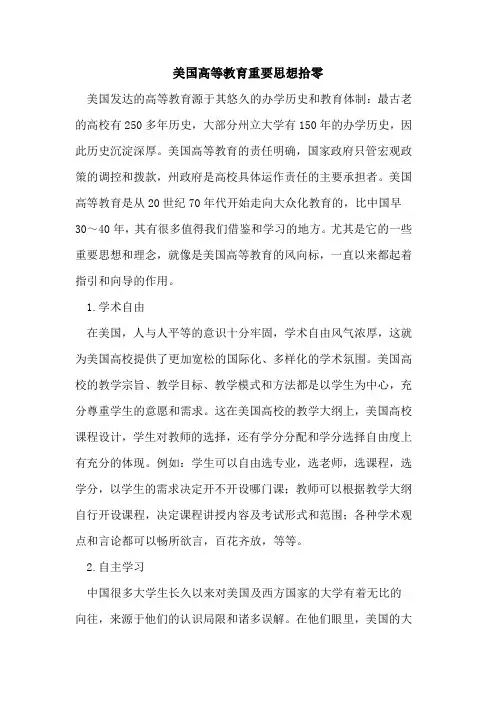
美国高等教育重要思想拾零美国发达的高等教育源于其悠久的办学历史和教育体制:最古老的高校有250多年历史,大部分州立大学有150年的办学历史,因此历史沉淀深厚。
美国高等教育的责任明确,国家政府只管宏观政策的调控和拨款,州政府是高校具体运作责任的主要承担者。
美国高等教育是从20世纪70年代开始走向大众化教育的,比中国早30~40年,其有很多值得我们借鉴和学习的地方。
尤其是它的一些重要思想和理念,就像是美国高等教育的风向标,一直以来都起着指引和向导的作用。
1.学术自由在美国,人与人平等的意识十分牢固,学术自由风气浓厚,这就为美国高校提供了更加宽松的国际化、多样化的学术氛围。
美国高校的教学宗旨、教学目标、教学模式和方法都是以学生为中心,充分尊重学生的意愿和需求。
这在美国高校的教学大纲上,美国高校课程设计,学生对教师的选择,还有学分分配和学分选择自由度上有充分的体现。
例如:学生可以自由选专业,选老师,选课程,选学分,以学生的需求决定开不开设哪门课;教师可以根据教学大纲自行开设课程,决定课程讲授内容及考试形式和范围;各种学术观点和言论都可以畅所欲言,百花齐放,等等。
2.自主学习中国很多大学生长久以来对美国及西方国家的大学有着无比的向往,来源于他们的认识局限和诸多误解。
在他们眼里,美国的大学就像是乐园,学生上课可以迟到,可以睡觉,可以把腿跷在课桌上,可以在任何时候打断老师的讲课随意发问;考试很多都是开卷,不考书上的知识,可以不用背书,有的甚至写篇文章就可以过关。
实际上,美国大学教师对学生的考评并不是学期末才完成的,而是每堂课都要记录发言成绩,平均约占总成绩的50%,这就要求学生均匀用力、不能放松。
在课堂上教授们讲得飞快,不管你听得懂听不懂,课下又留下一大堆阅读材料,读不完根本就完成不了作业。
课后要花很多时间看书,预习案例。
每堂课都需要提前做大量准备,课前准备充分了,上课时才能和别人交流,贡献个人思想,才能和大家一起学习,否则,根本无法融入到课堂教学中。
美国的学校教育分几级阶段美国的学校教育分为多个级别,每个级别对应不同的学生年龄和学习目标。
这些级别被称为“学历水平”,是划分教育系统的重要标准。
在美国的教育系统中,有四个学历水平:幼儿园、小学、中学和大学。
首先是幼儿园。
幼儿园是美国教育系统中最早的一个级别,适合3-5岁的学生。
在幼儿园,学生学习基础的认知技能和社交技巧,如颜色、数字、字母、分享、友谊和沟通等。
幼儿园通常被视为孩子们的第一步上学经历,是他们接触教育的契机。
接下来是小学。
小学是美国教育系统中较长时间的阶段,适合6到11岁的学生。
在小学,学生继续学习基础技能,如阅读、写作、算术和科学。
此外,学生也会学习其他学科,如社会研究、音乐、美术和体育。
小学的目标是让孩子们在各种学科中建立良好的基础。
然后是中学。
中学是美国教育系统中重要的一个阶段,适合12到18岁的学生。
中学致力于为学生打好大学入学的准备工作。
在中学,学生可以学习各种学科,如数学、历史、英语、科学和外语等。
此外,中学还有一些高级课程,如AP课程、荣誉课程和IB课程,这些课程为高中毕业生提供了更深入的学习体验。
最后是大学。
大学是美国教育系统中最高级别的一个阶段,适合18岁以上的学生。
大学通常被认为是为学生提供高等教育的最佳场所。
在大学,学生可以专攻自己最感兴趣的领域,例如商业、社会科学、人文科学和自然科学等。
此外,大学还提供一些职业培训方案,如医学、法律和工程等,许多人都希望通过大学获得更高的教育水平和向上流动的机会。
总的来说,美国的学校教育细分为4个层次:幼儿园、小学、中学和大学。
每个级别都有不同的目标和要求,从孩子们的基础学习到高等教育。
不管学生选择什么类型的学校,他们都可以在美国教育系统中找到适合自己的位置,并通过学习取得成功。
毕业论文中国和美国高等教育之间的差异The Differences of Higher Education between America and ChinaAbstractH igher education is an important approach to cultivate talented person. Different countries have different system of higher education. This paper aims at discussing the differences of higher education between China and America, and it not only puts forward the contrast analysis on the social environment, cultural tradition, education system and graduates ‘ability between China and America, but also analyzes the differences of the education reform measures between these two countries.Key words: Higher education; Difference; America; China中文摘要高等教育是培养人才的重要手段。
不同国家拥有不同体制的高等教育。
本文旨在讨论中、美两国高等教育的差异,它不仅提出了中、美两国社会环境和文化传统,教育制度和毕业生能力的对比分析,还分析了这两个国家教育改革措施的差异。
关键词:高等教育;不同; 美国;中国Contents:I. IntroductionII. Chinese-American social environment and cultural tradition differences2.1 Differences of attitudes on cultureIII. Chinese-American education system differences3.1 Different establishments of curricula and specialty3.2 Different choices of specialty curricula3.3 Different styles of inspecting students’ result3.4 Different styles of students’ management3.5 Different methods of teaching lessons3.6 Differences between public and private schoolsIV. Chinese-American graduates’ ability differences4.1 Differences of actual talents fosteredV. Chinese-American education reform measures differences 5.1 American reform measures5.2 Chinese reform measuresVI. ConclusionThe Differences of Higher Education between America and ChinaI. IntroductionIt is well known that higher education has been more and more significant all over the world. Because of the development of science and technology, the relationship between higher education and national politics, economy, science, culture, military is becoming closer and closer day by day. This mutual relation especially shows in aspect of higher education. The higher education is vigorous and upward, and it not only simply shows the growth of quantity, but especially has had the huge change in the nature. China and America share many characteristics in higher education. However this paper has mainly discussed the differences between Chinese and American higher education. The two countries are different in four significant aspects: (1)social environment and cultural tradition (2)education system (3)graduates ’ability (4)education reform measures.II. Comparison of the social environment and cultural tradition between China and America2.1 contrast of social environment and traditional education between China and AmericaAmerica is the biggest immigrant country. American economy emphasizes on the practical value, as well as individual value realization with fast development, rich material life, strong material idea and etc. The American advocates the independent way of life and work. The American owns full creative humanities spirit, the innovation is the forever subject in their brains. They pursue the hi-tech and prefer to compete.C ontrast with young USA, China is the great nation with glorious history and cultural traditions. The Chinese people have the excellent moral of modesty, but also have been over cautious and conservative. Though Chinese economy and technology is quite backward, it has very strong potential development, and Chinese students worked hard since they were small. Therefore China implements the policy of opening up, abundantly absorbs the benefit and enriches itself.The education between Chinese and American is extremely different. American education aims at building such an education to raise the creativity with less study and more thought. USA pays great attention to train the students’ practice ability to utilize the knowledge, cultivatingthe students to ask the knowledge and authority and building the ability to extend the knowledge system. That fact that 1/3 of numbers among all Nobel Prize winners in the world are the American is a very good illustration.Compared with American higher education, China’s higher education aims at building the foundation of education with more study and less thought; Chinese education pays more attention to instill and accumulate knowledge, cultivating the students’respect to the knowledge and authority and building the ability to inherit the knowledge system.III. Contrast of higher education system between Chinese and American3.1 different establishments of curricula and specialtyA nation’s higher education is the reflection of economic system. American education aims at adapting for society demand, they explicitly stipulate three big functions: education’s service for the economic development, the scientific research and teaching. The manifest of service in the establishment of specialty curriculum is to meet the social need and set up special curriculum or specialty which the society needs.In China's universities, during quite long period of time, the establishment of specialty curriculum lacks the change and could not follow social demand. In the latest few years, the majority of Chineseuniversities all started to pay great attention to the transformation and renewal of establishment of specialty curriculum so as to meet the need of society.3.2 different choices of specialty curriculaIn order to adapt the society, the American universities have established many specialties and curriculum of choice for students; the students choose or transform specialties and schools according to own interest and hobby. The American higher education system is extremely diverse and flexible, which is solo in the world higher education.In China, the student may choose the specialty according to own interest and hobby, but change of specialty in the school is not easy, transformation of school then is more difficult. In American universities, the compulsory courses are few, and elective courses are rich. While in Chinese universities, the compulsory subjects occupy the major part, and many schools(especially for technical colleges and universities)have the phenomenon of more emphasizing on the Science subjects, little on the liberal arts.3.3 different styles of inspecting students’ resultWhen American school inspects the result of student, they emphasize more on the ability to analyze and solve the question but not the ability of memory or description. The American student need the mechanical memorizing, but displays creative thought as far aspossible .This can cultivate students’study interest, raise the ability of doing it by self and make the study be one kind of creative activity.However, many teachers still adopted old teaching ways in Chinese universities, thus takes a test which needs mechanical memorizing. Such an inspection method has seriously attacked the students’ enthusiasm of study, caused the student to one-sidedly pay great attention to the theory and neglect the ability of practice.3.4 different styles of students’ managementIn the United States, many students at the school could conveniently take the IC card with a photo; the cards can be used to enter libraries and computer rooms and other facilities such as gymnasiums and other coliseum throughout the academy. Experienced consultants equipped by the school would help students to determine their main direction (major, a bit like our domestic professional) and guide students to choose specific classes. After selecting courses, in accordance with the school timetable, the septic time, place, classroom and course is entirely controlled by individual who means that everyone has the right of their own curriculum.Unlike American students, Chinese students also need arrangements of classes and dormitories. Compared with the USA’s IC card, our domestic student card and library card is similar to it. Except these, Chinese school has no experienced consultants to help students todetermine their main direction. As for the accommodation of students, some schools have a limited number of student dormitories, each school has a restaurant and fast-food shops, but most of them are always operated by outside operators where management are independent of schools. Most of students prefer to share a flat and live outside. So their dinner and lodging almost have no relationship with the school.3.5 different methods of teaching lessonsIn the United States inspiring students is great important for teaching. In classroom teachers will specially put forward some inspiring questions for students. In such a teaching mode, the students in the classroom have a higher degree of freedom, and they can be ready to make their own doubt for teachers which made the teaching atmosphere lively and vivid. This method of teaching helps to develop students’abilities of independent thinking and solving problem, however, this approach has a high demand for teachers which easily lead to a decrease in teaching quality and depth.China's higher education pays more attention to the systematic study. When teaching the curriculum, teachers should follow in accordance with certain teaching programs. Students have certain interactive questions, but this question tends to be discussed after the class, rather than in the classroom. It is the main mode that class is taught by teachers and students just listen to the records. This approachis conducive to help the students learn systematic knowledge. The class content is quite rich, but they have less sense of innovation.3.6 differences between public and private schoolsThere are more than 1500 public school of higher learning and more than 1600 private institutions in American. Both the public and private schools have a good reputation and high quality of the university. Very few Americans judge the quality not from the perspective of public and private schools, but from their teachers, courses and history.However, many Chinese believe that private schools can be unmatched with the public schools, and they are belittling or making an exclusion of private schools in heart. In private schools, Chinese people indeed should learn from the Americans, abandon the prejudice and make a correct and fair assessment for private schools.IV. Differences of quality and ability of graduates between China and US4.1 differences of actual talents fosteredIn actual talent fostered, the ability of adapting to society from American students was stronger than the Chinese Students. There are more and more opportunities to participate in social activities. Almost all the students have the experience of working outside. At the same time, civic education, campus cultural activities and community service activities in America increase the students’ability to adapt to thecommunity. While the Chinese Students stay under the closed campus for a long period,they have little direct ties to society and poorly understand the community, therefore Chinese students have to adapt to working atmosphere later than American’s students for two to three years.V.Difference of reform measures5.1 American reform measuresCurrently, American progress in the field of technology and knowledge occupies about 80 percent. The data is higher than one of the developed countries in Europe. Institutions of higher education should make indelible contribution to such a data. To meet the challenges of the 21st century, since the mid-1990s, the United States accelerates the reform of higher education systems which aimed at improving the quality of teaching and management efficiency and make greater contribution to the development of community and economy.Unprecedented expansion of social function of American University has become the power source for social development and progress. Therefore, the United States government policy-makers set off a new round of the 21st century-oriented reform of higher education to promote the development of higher education as a national goal of the important strategic initiatives.In the 21st century, the key point of American higher education reform is to achieve universal highereducation and make all over 18-year-old American youth have access to higher education.The overall idea of American Education reform is to build a higher education system which adapt to times’ demands. The most important measure is the reform of basic education and secondary education, the aim of idea is to meet the demand of adapting to the multiple reforms in future. To implement a strategic goal of universal higher education, the United States took a number of very innovative reform measures based on a substantial increase for education. These reform measures include: (1) implement small class teaching; (2) strengthen bilingual teaching, make college graduates more competitive and more adaptable; (3) improve the quality of teachers; in the system of employing teachers, schools take measures to employ formal teacher and informal teacher. In teaching methodology, teachers must adopt the modern teaching methods with integration of traditional media and modern media together for teaching.5.2 Chinese reform measuresRegarding the quality education as the most important thing, China's higher education implements the strategy of sustainable development, broaden the area of knowledge base, promote the integration of cross-disciplinary and connection between schools and society.Such a style aims at cultivating talents with a strong sense ofpioneering spirit, self-confidence, originality and boldly challenging the authority. China has been adhering to the reform of higher education for a long time. The most notable effect from the college merger is improvement of teaching effect. The College merger resolves some problems from the current teaching system uncoordinated with the international trend of socialization and market and enables educational resources to promote the effective allocation. The second measure is to set up the college courses in a market-oriented direction and adapt to the needs of society. Now in many school curricula’s is diverse, the initiative measures are taken to meet the needs of the market, at the same time a number of professionals closely related to social life are set up. The third initiative measure is based on the target of student-oriented.Since the 20th century, China's higher education emphasized the training of personnel ability, including the ability of acquiring knowledge, ability of analysis and problem-solving, ability of creating and certain organizational ability. At the same time the concept of quality education is put forward, which emphasizes the ideological and moral qualities, cultural quality, physical and mental quality. As a main part, students are not only the educated ones, but also participants of education.VI. ConclusionAll in all ,America’s higher education is different from China’s, it mainly performs through four points (1)social environment and cultural tradition (2)education system (3)graduates ‘ability (4)education reform measures. In order to reduce these differences, we should take some appropriate measures.In order to decrease the distance between Chinese higher education and American higher education, we should understand the difference of higher education between China and American, and absorb the advantages to profit from the American higher education and the development of our higher education. First of all, China's higher education should change from the "examination-oriented education" to "quality education". What is more, Chinese higher education should establish”people-oriented”education concepts. Besides, Student's sense of participation should be fully prominent in teaching practice. Teaching should focus on taking individualized teaching methods, strategies and techniques, widely apply the science teaching methods such as "free discussion", "self-study", make teachers and students exchange their ideas free, train students to learn initiative and creativity, promote students’initiative and creativity. Moreover, teaching management should achieve the reunification of system and flexibility.References[2] 丁往道,吴冰,英语写作基础教程[M],高等教育出版社,1998[1] 李泽同,透视美国[M],北京对外经贸大学出版社,2003[3] 史静寰,当代美国教育[M],北京社会科学文献出版社,2004[4] 吴明熹,教育政策的基本价值取向[J],高教研究参考,2006[5] 谢安邦,七方教育丛书[J],中国社会科学出版社,2001[6] 袁衍喜,现代教育改革探索[M],北京人民教育出版社,1987[7] 张文英,中美高等教育比较与启示[J],黑龙江高教研究,2005THANKS !!!致力为企业和个人提供合同协议,策划案计划书,学习课件等等打造全网一站式需求欢迎您的下载,资料仅供参考。
美国的教育体系与我国有所不同,其学校年级制度也呈现出独特的特点。
下面将详细介绍美国学校年级制度的划分、学制以及教育理念。
一、美国学校年级划分美国学校年级制度分为三个阶段:小学、中学与高等教育。
1. 小学:通常包括1-6年级,称为Elementary School。
这一阶段的教育重点在于培养学生的基本学习能力和社交能力。
2. 初中:包括7-8年级,称为Middle School。
这一阶段的教育重点在于培养学生的独立思考能力和实践能力。
3. 高中:包括9-12年级,称为High School。
这一阶段的教育重点在于培养学生的专业素养和综合素质。
此外,美国学校还设有幼儿园,通常为3-5岁儿童提供教育,称为Preschool或Kindergarten。
二、美国学校学制美国学校学制分为两种:6-3-3制和6-2-4变通制。
1. 6-3-3制:小学6年,初中3年,高中3年。
这是美国最常见的学制。
2. 6-2-4变通制:小学6年,初中2年,高中4年。
这种学制在美国部分州和地区实行。
此外,还有一些地区采用8-4学制或6-6学制,但较为少见。
三、美国学校教育理念1. 个性化教育:美国学校注重学生的个性化发展,鼓励学生根据自己的兴趣和特长选择课程,培养学生的自主学习能力。
2. 重视实践:美国学校强调理论与实践相结合,注重培养学生的实践能力,如实验、实习、社会服务等。
3. 注重综合素质:美国学校注重培养学生的综合素质,包括领导力、团队协作、沟通能力等。
4. 鼓励创新:美国学校鼓励学生敢于质疑、勇于创新,培养学生的创新精神。
四、美国学校年级制度的特点1. 学制灵活:美国学校学制较为灵活,学生可以根据自己的实际情况选择适合自己的学制。
2. 课程丰富:美国学校课程设置丰富,学生可以选择多样化的课程,满足不同学生的需求。
3. 教育公平:美国学校注重教育公平,为每个学生提供平等的教育机会。
4. 国际化程度高:美国学校国际化程度较高,吸引了来自世界各地的学生。